Attitude of Rural Farming Household towards the Consumption of Edible Mushrooms in Dekina Local Government Area, Kogi State, Nigeria
Adejo PE* and Ademu H
Department of Agricultural Economics and Extension, Kogi State University, Nigeria
Submission: December 4, 2017; Published: February 15, 2018
*Corresponding author: Adejo PE, Department of Agricultural Economics and Extension, Kogi State University, Anyigba, Kogi State, Nigeria, Email: emmypar2002@yahoo.couk
How to cite this article: Adejo PE, Ademu H. Attitude of Rural Farming Household towards the Consumption of Edible Mushrooms in Dekina Local Government Area, Kogi State, Nigeria. Nutri Food Sci Int J. 2018; 5(3): 555661. DOI: 10.19080/NFSIJ.2018.05.555661.
Abstract
The study was carried out to examine the attitude of rural farming households toward the consumption of edible mushrooms in Dekina Local Government Area of Kogi State, Nigeria. A total of 160 respondents were randomly selected for the study. Data collected through the use of interview schedule were subjected to descriptive statistics and binary logit regression model. Result shows that most (70.4%) of respondents were in their youthful ages, mostly (70.30%) male dominated and have attained one form of formal education or the other. It was indicted that majority (80.00%) highly preferred to consume mushrooms with 63.10% prefering to consume it in its parboiled dietetic form. About 63.00% of the respondents said mushrooms were normally consumed as a close substitute to meat or fish and also claimed to consume it for medicinal purpose. Analysis on the logit regression shows that age and sex had positive effects, while education had negative effects on their preference for the consumption of mushrooms. It is recommended that both public and private extension agent (with help of nutrition/home economics subject matter specialists) should create awareness and encourage consumption mushrooms and training on how to cultivate mushrooms.
Keywords: Mushrooms; Auricula auricularia; Oru-EHkpo
Introduction
Mushrooms, a member of the fungus family are a choice crop for small scale farmers because of the biological makeup and fast growth rate (usually 3 weeks). They can be cultivated domestically or picked in the wild, with some growing above the ground and others growing below the ground, they are edible cash crops with a large global demand.
Several researchers have been working on the growth requirements of some edible species as well as the development of new desired strains. Mushrooms are cultivated worldwide for their taste, nutritional value and their potential as medical mixture and drugs [1,2]. Mushrooms are eaten both for their nutritional and medicinal values. Although the nutritional and medicinal values depend on the types of species consumed. Mushrooms are rich in protein, Vitamin B, contain moderate amount of vitamin C and minerals. They are, however, low in carbohydrate and are generally preferred to fresh vegetables because weight for weight, the body absorbs all of mushrooms eaten without wastes [3]. Their cultivation, which is not just fuelled by their various uses in staple meals, is also largely motivated by their wide medicinal uses, and as such, are cultivated and sold commercially in over 60 countries including Nigeria, The United States, France, Poland, Netherlands, and a host of other countries [4]. Mushrooms are natural product with many nutritional advantages. They are cholesterol free and contain virtually no fat or sodium, all of which dieticians say need to be reduced in diets. Mushrooms supply dietary fibre and are a good source of several important; B group vitamins, especially niacin and riboflavin. Raw dietary mushrooms are a good source of B vitamins, such as riboflavin, niacin and pantothenic acid the essential minerals, selemium, copper and potassium. Fat, carbohydrate and calorie content are low, with absence of vitamin C and sodium. Mushrooms are a low-calorie food usually eaten raw or cooked to provide garnish to a meal [5,6].
According to Okungbowa [7] past unpalatable experiences with poisonous mushrooms, people are skeptical about their safety. As a result, the consumption of wild mushrooms is now becoming unpopular except for a few species of Pleurotus and Auricularia that are so common that their identity cannot be mistaken. Specifically, edible species are: Lentinus squarrosulus, Auricularia auricula, Lepiota sp, Termitomyces spp, Volvoriella esculenta, Lycoperdon spp among others. The poisonous mushrooms also belong to the order Agaricales. However further taxonomic grouping place most poisonous mushrooms in the genus Amanita while other genera such as coprinus lactariusand Clitocybe which contains a few poisonous species [8]. Differentiating poisonous from edible mushrooms is normally done by the elders in the rural areas. Many delicious edible mushrooms can be prepared. Edible mushrooms are eaten a lot in the study area with some selected soups like okro (oro) and melon (egusi) soups. These actually depend on the dietary habits of the people. Some of the common recipes containing mushrooms are roasted mushrooms and its salad.
Nigeria is a developing nation where majority of the people live below average poverty level. This means that the common man is unable to afford the conventional sources of proteins, vitamins, mineral salts and other essential nutrients needed by the body. The recognition of these calls for cheaper and readily available alternative sources of protein and the other nutrients. Despite the fact that edible mushrooms are found to contain high quality proteins, vitamin and minerals and that numerous species of it are found personally across the various regions of Kogi State especially in Dekina Local Government area; the appraisal of edible mushroom as cheap alternative source of protein, vitamin and minerals as well as concerted effort of rural household in the cultivation and preservation of the edible mushrooms are not widely reported, hence the need mushrooms are not widely reported, hence the needs to access the attitude of the rural farming household toward the consumption of the edible mushrooms. Base on these, the following research questions are said to be pertinent: What are the socio-economic characteristics of mushrooms consumer? What are species of mushroom normally consumed among the farming household? Do the farmers have any reasons for consuming mushroom? What are the factors affecting mushroom consumption among farmers in the study area? What are the preferable dietetic form(s) of mushrooms do the farmers consume? Do the socio-economic characteristics of rural farmers in Dekina Local Government Area have effect on their consumptions of edible mushrooms?.
Objectives of the study
The specific objectives are:
I. Describe socio-economic characteristics of the mushrooms consumers in the study area.
II. Identify the species of mushrooms commonly consumed.
III. Examine the perception of the farming households on major reasons for the consumption of edible mushrooms.
IV. Assess the factors affecting mushrooms consumption in the study area.
V. Examine the dietetic form(s) preferred by mushroom consumers in the study area.
VI. Determine the effect of the farmers' socio-economic characteristics on their consumption of edible mushrooms.
Null Hypothesis (H0)
The socio-economic characteristics of rural farmers have no significant effect on their consumption of edible mushroom.
Methodology of the Study
The study was carried out in Dekina Local Government Area of Kogi State, Nigeria. Dekina Local Government lied between the latitude 7°27'N-7°31'N, longitude 7°09'E-7°12'E, and it has a land mass area of 261km2 (950 miles) and a population of 260, 312 (NPC, 2006).
The population for this study comprise of all the rural farmers from Dekina Local Government Area. A total of 160 farmers were randomly selected and interviewed. Interview schedule was used to elicit information from the farmers since they were mostly illiterates. Prior to collecting data, a preliminary survey was conducted regarding the practice of the inhabitants in the study area in relation to mushrooms consumption habits and general information. Farmers of age between 18 and above were used in the study area. Data collected from the field survey was subjected to both descriptive and Binary Logit Regression. Binary logit regression model was used to analyse the effect of some selected socio-economic characteristics of farmers on the consumption of edible mushrooms.
Binary logit regression model was expressed implicitly and explicitly as follows:
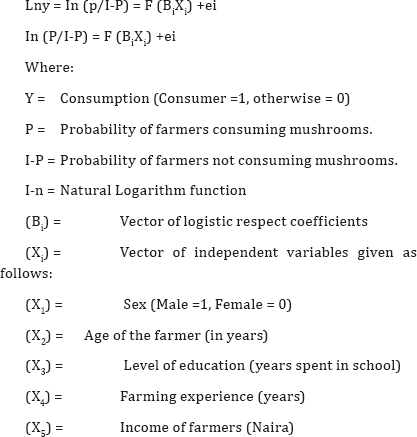
Results and Discussion
Socioeconomic Characteristics of the Respondents
The socio-economic characteristics of the respondents are presented in Table 1. The socio-economic variables considered in this study include sex, age, educational level and major occupation.
Majority (63.1%) of the respondents in the study area were males while 36.9% were females. This indicates that more males were found to be household heads than the females. This is common in African society where males always assume headship position.
Result in table also shows that 9.4% of the respondents were within the age bracket of 18-28 years, 21.8% were within the age range of 29-38 years, 17.5% fall within the age of 39-48 years, 48.8% were within the age of 49-58 years while 2.5% fall within the age of 59-68 years. One of the important factors which can positively or negatively affect the consumption of mushroom is age. The younger ones are could be more interested in mushroom consumption compared to the aged.
In terms of educational level, the result indicates that 11. 3% of the respondents had no formal education, 10.6% had primary education, 34.4 % had secondary education and 43.8% had tertiary education. This shows that most household heads in the study area could read and write.
It was reflected that 30.6% were traders while 38.8% and 30.6% were farmers and civil servants respectively. This implied that farming is the major occupation among rural households in Dekina Local Government area of State.
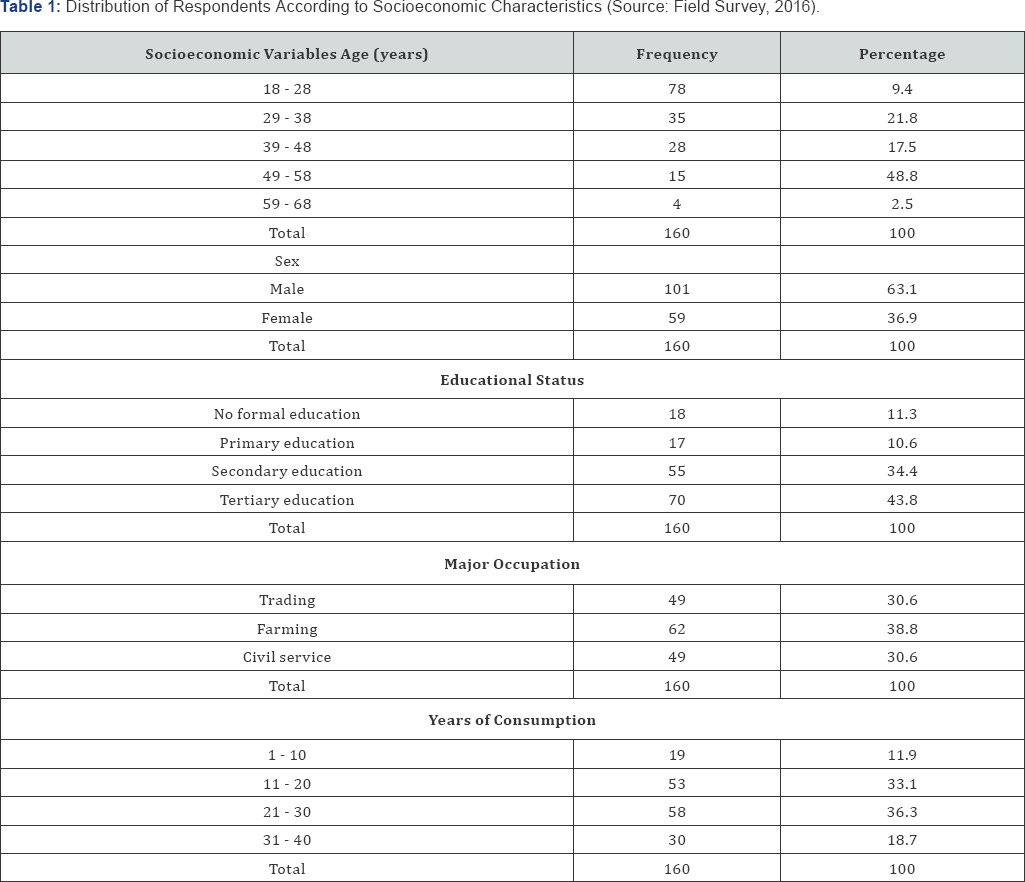
The distribution of respondents according to years of consuming mushroom showed that 36.3% have been consuming mushroom from 21-30 years, 33.1% have been consuming mushroom for 11-20 years, while 18.7% and 11.9% of the respondents have been consuming mushroom for 31-40 years and 1-10 years respectively. This result is an indication that mushroom consumption in the study area have been on over the years. It is expected that the respondents would be well informed in terms of the nutritional content of mushroom and other related information (Table 1).
Species of mushroom consumed
Table 2 shows that Oru-olih (Auricula auricularia) ranked 1st as the most consumed edible mushroom specie with a percentage of 78.8. This was followed by Oru-Elikpo (Trimela fungi formis) and Oru-Akpetina (Redstropharia) with 68.1% and 48.1% respectively. By implication, most (78.80%) farming households in the area majorly consumed Oru-olih (Auricula auricularia). High consumption of this specie by households could be attributed to its nutritive value, palatability and medicinal content (Table 2).
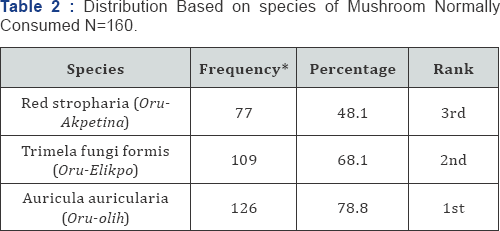
* = multiple response
Source: Field Survey, 2016
Reasons for mushroom consumption
The major reasons for mushroom consumption identified by the respondents are presented in Table 3. The result shows that 63.1% of the respondents consumed mushroom for its medicinal purpose, 54.4% consumed mushrooms for its edibility (make soup sweet), 62.5% of the respondents consumed mushrooms as a close substitute to meat or fish while 61.3% of the respondents consumed for its nutritional importance or value (Table 3).
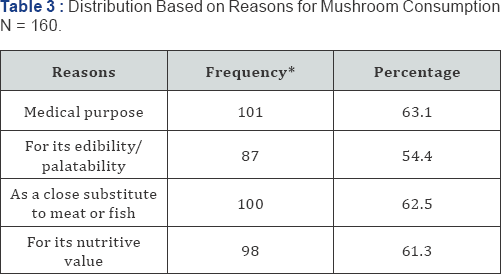
* = multiple response
Source: Field Survey, 2016
Factors affecting mushroom consumption
The major factors affecting mushroom consumption are presented in Table 4. Seasonality of production was the most (76.3%) common factors identified by the respondents. Also, 48.1% were affected by problems of identifying edible species, 34.4% were affected by allergy in consumption, 40.0% had indicated knowledge of preservation, 25.6% had problems of poor shelf-life and 39.4% were affected by market proximity. Edible mushrooms are important food sources for rural communities, particularly during the rainy season. The mushrooms are mostly common during rainy season than dry season, as from the months of May to November; edible mushrooms are mostly available in the study area (Table 4).
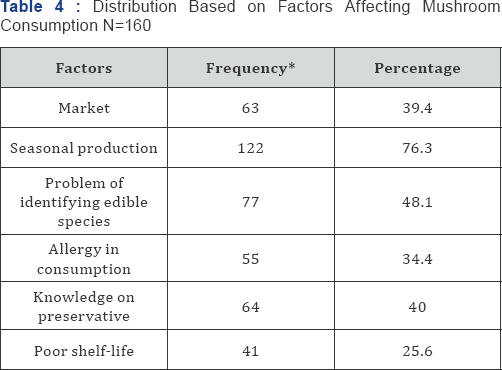
* = multiple response
Source: Field Survey, 2016
Preference of dietetic form of mushroom consumption
Table 5 shows that majority (63.1%) of the respondents prefer to consumed mushroom in the parboiled form, 16.3% preferred it roasted, 30.0% preferred it in the dried form and 8.8% preferred to consume mushrooms in the fried form. The high preference for the parboiled form could be attributed to its ease of preparation. People preferred the parboiled form because it involved less processing compared to another even though, the fried form is very palatable, it takes longer time in processing and the dried form required longer time for processing than roasted.

* = multiple response
Source: Field Survey, 2016
Influence of socio economic characteristics on mushroom consumption
Estimate of the binary logistic regression on the influence of socioeconomic variables on mushroom consumption is presented in Table 6.
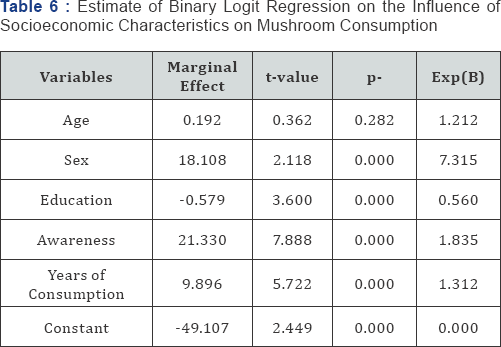
Log-likelihood= 346.876, LR x2 = 60.060, Prob> x2 = 0.000; Pseudo R2= 0.313
Source: Computed from Field Survey Data, 2016.
Age
The analysis in Table 4 shows that age has positive marginal effect on the mushroom consumption. This implies that an increase in age increases the probability of the respondents to consume mushroom in the study area. The odds of consumption increases by 1.212 times as age increases.
Sex
Sex has a positive effect on mushroom consumption. This variable was also significant at 1% level of significance. This implies male headed households are likely to consume mushroom compared to female headed households. This finding could be associated to accessibility by male headed households since they are mostly involved in farming. The odds of consumption increases by 7.315 times in favour of the males as opposed to the females.
Education
Number of years spent schooling negatively influenced the probability of mushroom consumption at 1% level of significance. This inverse relationship could be attributed to affordability to other substitute as against mushroom. Respondents with higher educational level could have more income with high purchasing power in sourcing other substitutes to mushroom such as fish, egg and beef. The odds for consumption decreases by 0.560 times with respect to an increase in years spent schooling.
Awareness
The marginal effect of awareness on mushroom consumption was also positively signed and significant at 1%. This implies that the probability for mushroom consumption among farming households increases with awareness. Household who are aware of mushroom and its associated benefits/value, tends to consume it more than households who are not. From the result, the odd of mushroom consumption is 1.835 times greater for those who aware as opposed to those who are not.
Years of Consumption
The number of years spent in consuming mushroom positively influenced the probability of mushroom consumption. This effect was also significant at 1%. By implication, the probability of mushroom consumption increases with more years of consumption. Households who have been consuming mushroom over a period tends to consume more and continue consumption probably due to its nutritive value and other associated benefits. The finding also indicated that the odds of mushroom consumption increases by 1.312 times with an increase in years of consumption.
Conclusions and Recommendation
This study was carried out to examine consumption of mushrooms by rural dwellers in Dekina Local Government Area of Kogi State. It was indicated that 63.1% of the respondents were males with 66.3% in the age group of 39 - 58 years. Also, 88.7% had formal education with farming as the major (38.8%) occupation.
Investigation on the major species of mushroom consumed revealed that most of the farming households in the area consumed Auricula auricularia (Oru-olih), Trimela fungi formis (Oru-Elikpo) and Red stropharia (Oru-Akpetina) with 78.8%, 68.1% and 48.1% respectively.
On reasons for mushroom consumption, it was revealed that farming households in the area consumed mushroom for: medicinal purpose (63.1%), substitute to fish (62.5%), nutritive content (61.3%) and its edibility (54.4%).
The major factors that affect mushroom consumption in the area include: seasonality of production (76.3%), identification of edible species (48.1%) and knowledge on mushroom preservation (40%). Despite the factors, 63.1% of households in the area preferred mushroom when parboiled.
Estimate of the binary logistic regression revealed that 31% of the variations in mushroom consumption were predicted by the included explanatory variables. Additionally, sex, awareness and years of consumption positively influenced the probability of mushroom consumption at 1% level of significance, while the marginal effect of years spent schooling was inversely signed at 1% level of significance.
Conclusion
It can be concluded from this study that majority of the inhabitants in Dekina Local Government Area of Kogi State have awareness about mushrooms consumption and they like eat because they believe that eating mushrooms substitutes meat and fish. From this study, Auricula auricularia (Oru-olih) was majorly consumed by rural dwellers in the area for its medicinal value and ease of preparation. However, mushroom consumption is affected by seasonality of its production. It can also be inferred from this study that sex, awareness, education and years of consumption significantly influenced mushroom consumption among farming households.
Recommendations
Based on findings from the study, the following are therefore recommended:
I. Effort should be made by extension agents to organize training programmes directed toward consumption and production of mushrooms, seminars, workshop and agricultural shows on practical guide for production and consumption should be organize for clientele. This undoubtedly will improve on their knowledge, skill and techniques in small scale production which lead to increased in consumption of mushrooms and subsequently lead to higher protein intake from mushrooms and better improved health status. The health status such as diabetic management, weight loss, cancer, high blood pressure and heart problem. More research on mushrooms should be carried out to aid more consumption of mushrooms. From this study, it is clear that mushrooms could be regarded as highly nutritious delicacies that can be used as a protein supplement in diets for people of all ages including strong bones and obesity because of their low fat and sugar contents.
II. Effort should made to re-orientate the people of the area since the mushrooms are used to cured many diseases and the reasons for consume mushrooms. So as to encourage people to consume mushrooms.
III. Easy means of preparation and storage of mushrooms is also imperative.
References
- Lim BO, Yamada K, Cho B, Jeon T, Hang SG, et al. (2006) Comparative Study on the Modulation of Ige and Cytokine Production by Phellinus Grown on Cultivated Brown Rice, Murine Splenocytes. Biosci Boitechnol Biochem 86 (11): 2391-2394.
- Mata G, Hemande DM, Andrew LG (2005) Changes in Liggnocelluloytic enzyme activities in six strains cultivated on coffee pulp in confrontation with Trichoderma spp. World J Microbial 21(2): 143-150.
- Okhuoya JA (2015) Nigeria must tap into the Multi-million dollar Mushroom Market.
- Edom S (2016) How to Start a Lucrative Mushroom Farming Business in Nigeria: The Complete Guide.
- Mattila P, Konko K, Eurola M, Pihlava JM, Astola J, et al. (2001) Contents of vitamins mineral elements and some cellulose compound in cultivated mushroom. J Agric Food Chem 49(5): 2343-2348.
- Moor D (2005) Principles of mushrooms developmental biology. Inter J Med Mushrooms 7: 79-101.
- Okungbowa FI (2005) Commercial Cultivation of Edible Mushrooms in Nigeria. International Journal of Medicinal Mushrooms 7(3): 441.
- Mcnabb RFR, Talbot PHB (1973) The fungi: and advanced Treatise, VIB, Academic Press, New York, USA, pp. 317-325.






























